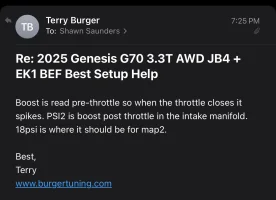zombiedude
Member
- Joined
- Feb 27, 2025
- Messages
- 28
- Reaction score
- 6
- Points
- 3
Just hooked up my JB4 to my 3.3T and was running some data logs and had some confusion between what ECU_PSI and Boost measured. My map2 log shows a peak of 23.8psi on the “boost” line, but 18.6psi on “ECU_PSI” line.
From what I read, stock, this car gets 16-18psi, is that correct? Would that mean my car is barely over stock psi? It physically feels much faster. Or is that 16-18 relative to the “boost” in which I’m making significantly more.. very confused. All things considered, I’m not trying to get more power, it feels plenty fast, I just want to know what numbers I’m looking at.. When someone here says they made 20psi which are we referring to, and what is “high” for the stock turbos?
From what I read, stock, this car gets 16-18psi, is that correct? Would that mean my car is barely over stock psi? It physically feels much faster. Or is that 16-18 relative to the “boost” in which I’m making significantly more.. very confused. All things considered, I’m not trying to get more power, it feels plenty fast, I just want to know what numbers I’m looking at.. When someone here says they made 20psi which are we referring to, and what is “high” for the stock turbos?






